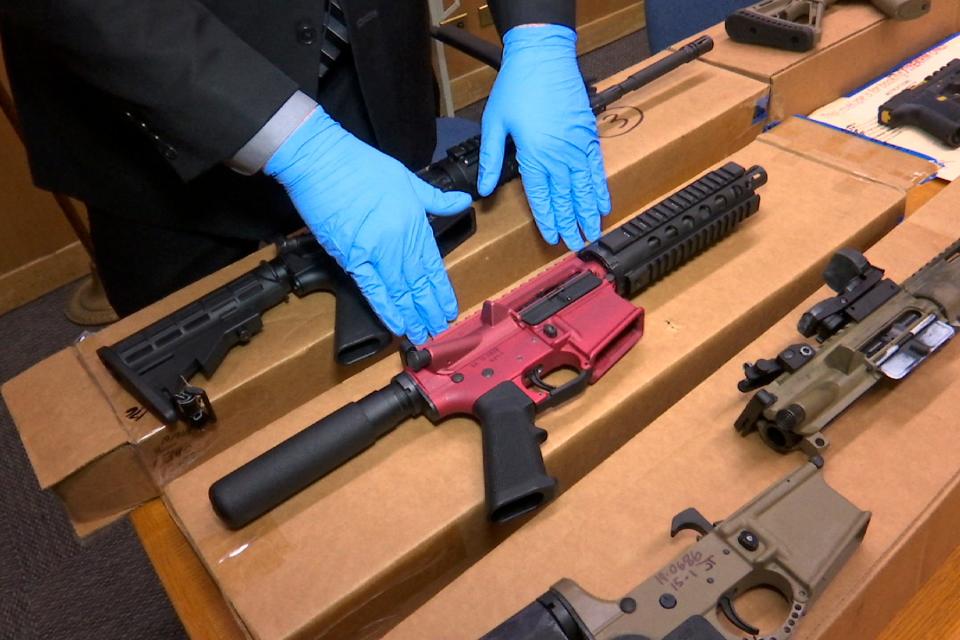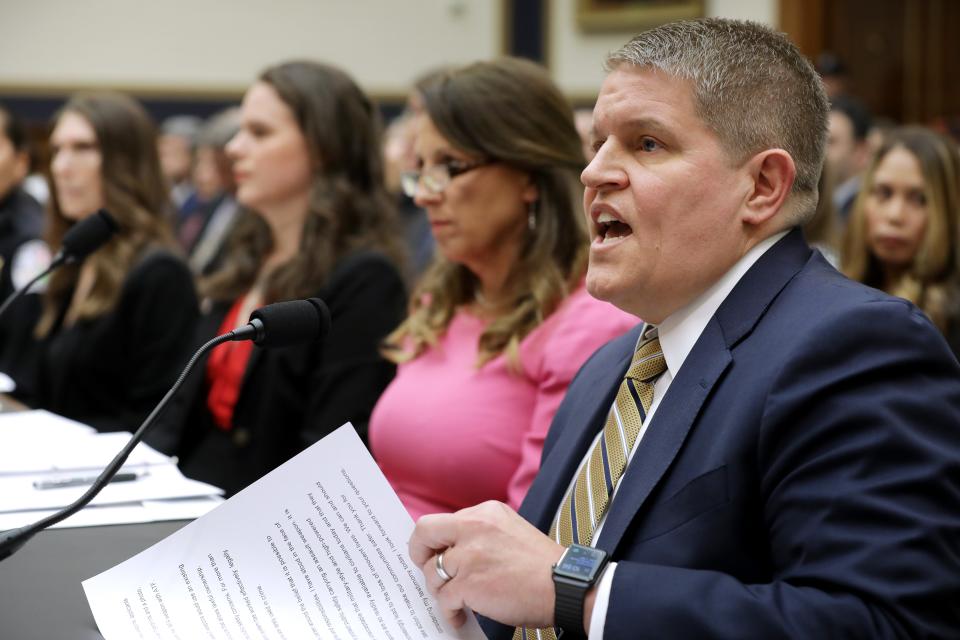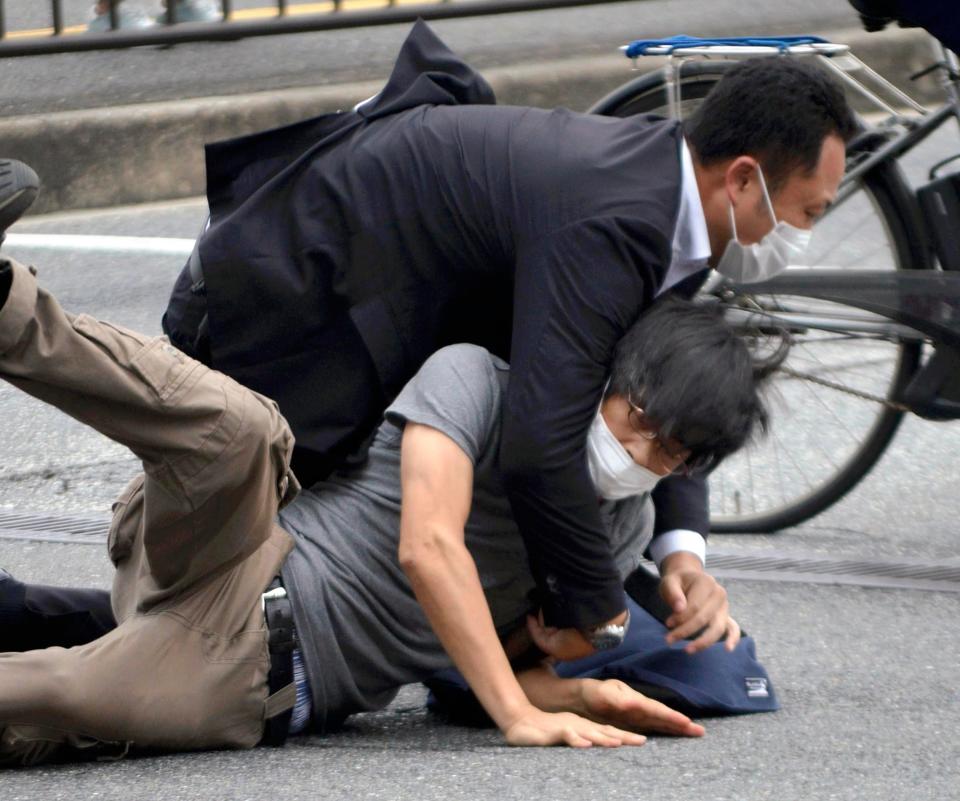Homemade gun used in assassination of Shinzo Abe; attack highlights flood of 'ghost guns' in U.S.
- Oops!Something went wrong.Please try again later.
Former Japanese Prime Minister Shinzo Abe was killed by an attacker wielding what police and other officials have described as a homemade gun, a rare shooting in a country with some of the world's most restrictive firearm laws.
The attack's link to a self-made weapon immediately highlighted the recent proliferation of so-called "ghost guns" in the U.S., largely untraceable firearms assembled from kits often purchased online that sidestep background checks.
According to the Justice Department, 20,000 ghost guns were recovered last year in criminal investigations, marking a 10-fold increase from 2016.
The troubling statistics were cited by President Joe Biden in April, when he unveiled federal regulations targeting such privately made firearms that do not carry serial numbers making them difficult to trace.

Unfinished parts sold in gun kits, like the frame of a handgun or receiver of a long gun, now qualify as firearms under federal law.
Japanese authorities have not identified where the suspect, identified as Tetsuya Yamagami, 41, purchased the firearm components, either assembling himself or with a kit. A raid of the suspect's home yielded other similar weapons.
Gun control in Japan:Shooting deaths are rare in Japan. What we know about the nation's strict gun laws
Reactions to Abe's death: 'Stunned, outraged and deeply saddened.' Biden, other leaders react to Shinzo Abe assassination
An assassin's crude weapon
Stumping for a candidate in advance of Japan’s upper house elections, Abe was allegedly shot from behind with the crude firearm.
Television reports showed the gun appeared to be covered in black tape, with two barrels fastened together on a wood base. Videos and images of the weapon have circulated from Japanese public broadcaster NHK.
The weapon, described by police as slightly more than a foot long and eight inches high, was being treated with caution out fear of an uncontrolled discharge.
'It's almost like he's firing fireworks at the guy'
David Chipman, a former Bureau of Alcohol, Tobacco, Firearms and Explosives official and Biden's first nominee to lead the agency, said he's never seen a homemade gun like the one linked to the suspect.
From the available photographs, Chipman noted the weapon's exposed wires, indicating an electrical circuit of some kind. The electrical mechanism could suggest it was a way of evading Japan's strict gun laws.

"This guy couldn't get traditional ammunition probably, because it's highly regulated," Chipman told USA TODAY. "He had to basically make an explosive. We call it a shaped charge."
Chipman expects the method of obtaining the explosive powder and ammunition to be a focal point in the investigation. Assembling a homemade gun is easy but obtaining the materials to fire it is the hard part, he said.
"You need the thing that goes 'boom'," said Chipman.
He emphasized how the gun appeared to be extremely crudely made, saying it looked like "something during the pre-ghost gun era in the United States."
"It's almost like he's firing fireworks at the guy."
Max Houck, an international expert in forensic science at the Florida International University's Global Forensic and Justice Center, said that from his review of media photos and images online, the weapon the individual in Japan was arrested with does not appear to be a weapon made with a 3-D printer.
“It looks homemade – it’s pretty big, it’s pretty bulky, there’s a lot of what appears to be black electrical tape on it and two cylinders taped together, so it does not look like a 3-D printed gun at least at the barrel portion,” Houck said. “It looks pretty crude.”
The so-called 3-D firearms fall under the umbrella of ghost guns.
Unlike homemade firearms which can be made from do-it-yourself kits, the assembly of a 3-D printed firearm can start entirely from an individual's home. With a 3-D printer and computer, an individual can download the schematics of a firearm and assemble the weapon.
Ghost guns: Amid rise of gun violence, Biden unveils 'basic common sense' regulations targeting ghost guns
The Biden administration included 3-D printed firearms in its new rules established in April to crackdown on ghost guns. Any 3-D printed firearms that reach a licensed dealer or gunsmith must be serialized before being sold to a customer, starting a line of possession for authorities to track if needed.
A shock to the country
In a nation with restrictive gun control, the shooting shocked the Japanese community as gun violence – especially against political leaders -- is rare. The last time a current or former Japanese prime minister was shot and killed was 90 years ago.
Only shotguns, air guns, guns with specific research or industrial purposes or those used for competition are allowed in Japan. Owning a gun in Japan requires a rigorous background check and instruction process with Japan’s Public Safety Commission.
Japanese police said it remains unclear whether Yamagami had proper licenses for his weapons.

The estimated total number of guns in Japan in 2019 was 310,400, according to Japan’s National Police Agency, amounting to .25% of civilians.
Firearm owners in Japan are subject to inspections by police every year, further driving down the number of private gun owners in the country.
Possessing more than one gun or owning a gun as part of an organized gun syndicate carries up to a 15-year prison sentence under Japanese law. Discharging a gun in a public space can result in a life sentence.
Contributing: Associated Press
This article originally appeared on USA TODAY: Abe assassination: Homemade weapon in attack highlights 'ghost guns'

